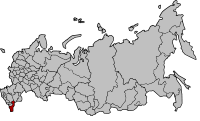Tabassaran
Facts
- Language: Tabassaran
- Alternate names: Ghumghum, Tabasaran, Tabasarantsy
- Language code: tab
- Language family: Nakh-Daghestanian, Daghestanian, Lezgic, Samur, Eastern Samur, Tabasaran-Aghul-Lezgi
- Number of speakers: 126900
- Vulnerability: Vulnerable [Read more...]
- Script: Cyrillic script
More information:
Introduction
The Tabasaran language belongs to the southeast group of Dagestan languages (the Lezgi-Samur languages). Administratively, the Tabasarans do not inhabit a single defined territory but are spread through the Tabasaran (centre, Khuchni) and Khiv (centre, Khiv) districts of Dagestan.

Dagestan on Russian map
In the former, there are 98 Tabasaran settlements, in the latter, 25. While the population of the Tabasaran district is ethnically homogeneous, half of the population of the Khiv district are Lezgis. The major Tabasaran settlements are Khiv, Khuchni, Kandik, Kushtil, Lyakhle, Djuli, Tchere, Mejkyul, Kurag, Tinit, Arkit, Dyubek and Shirtich. Their neighbours to the north are Dargwas, to the south, Lezgis, to the west, Aguls and to the east, Azerbaijanis.
After the Lezgis, the Tabasarans are the second largest people among the Lezgian-Samur language speakers.
Tabassaran Verb
The verb system is relatively simple; verbs agree with the subject in number, person and (in North Tabasaran) class.
Verblist
- апӏуб
- масу тувуб
- тувуб
- фикир апӏуб